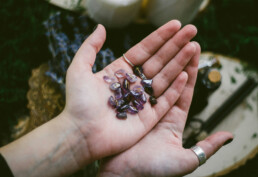The Elder Futhark is the oldest known runic alphabet, used by Germanic tribes between the 2nd and 8th centuries CE. Comprising 24 symbols, it was carved into stone, wood, and metal for inscriptions, magic, and divinatio runic alphabet used by Germanic tribes. Each rune holds a phonetic sound and symbolic meaning, representing concepts like strength, joy, protection, and transformation. The runes are grouped into three aettir (families) of eight, each linked to different life themes. Today, the Elder Futhark is used in modern spirituality and Norse-inspired practices to gain insight, channel energy, and connect with ancient wisdom through meditative or divinatory methods.

ᚠ Fehu (F) – Wealth, Prosperity
Fehu represents movable wealth such as cattle or money. It symbolises abundance, success, and new beginnings, but warns against greed and stagnation.
ᚢ Uruz (U) – Strength, Health
Uruz signifies primal power, endurance, and the untamed force of nature. It can also represent healing and physical vitality.
ᚦ Thurisaz (Th) – Defense, Challenge
Thurisaz stands for giants or destructive forces. It signals a need for caution, protection, or confronting challenges with inner strength.
ᚨ Ansuz (A) – Wisdom, Communication
Associated with the god Odin, Ansuz embodies divine communication, learning, and inspiration. It encourages clarity, truth, and messages from spirit.
ᚱ Raido (R) – Journey, Movement
Raido signifies travel—literal or spiritual. It brings themes of rhythm, progress, and navigating life’s path with purpose and discipline.
ᚲ Kenaz (K) – Knowledge, Illumination
Kenaz is the torch, representing enlightenment, creativity, and transformation. It brings insight and clears away ignorance or confusion.
ᚷ Gebo (G) – Gift, Exchange
Wunjo signals happiness, fulfillment, and harmony. It often indicates emotional or spiritual resolution and a time of peace.
ᚺ Hagalaz (H) – Disruption, Change
Hagalaz is the hailstorm—symbolizing unavoidable disruption. Though chaotic, it clears space for needed transformation and growth.
ᚾ Nauthiz (N) – Need, Restriction
Nauthiz reflects limitations and hardships. It urges patience and perseverance while also highlighting the strength that comes from adversity.
ᛁ Isa (I) – Stillness, Ice
Isa is stasis, stillness, and clarity. It may advise pausing or caution and warns of emotional coldness or delays.
ᛃ Jera (J/Y) – Harvest, Reward
Jera is the cycle of seasons and time. It symbolizes fruition, reward for effort, and the natural rhythm of life.
ᛇ Eihwaz (Ei) – Endurance, Transition
Eihwaz represents the yew tree, death and rebirth, and spiritual resilience. It points to transformation and the ability to overcome difficulty.
ᛈ Perthro (P) – Mystery, Fate
Perthro is the rune of secrets, chance, and the unknown. It relates to intuition, hidden knowledge, and the unfolding of destiny.
ᛉ Algiz (Z) – Protection, Higher Self
Algiz is the elk or shield, a powerful rune of protection and divine connection. It urges alignment with one’s higher purpose.
ᛊ Sowilo (S) – Success, Vitality
Sowilo is the sun, symbolising success, clarity, and personal power. It offers encouragement, illumination, and energetic breakthroughs.
ᛇ Eihwaz (Ei) – Endurance, Transition
Eihwaz represents the yew tree, death and rebirth, and spiritual resilience. It points to transformation and the ability to overcome difficulty.
ᛏ Tiwaz – Justice, Leadership, Sacrifice
Tiwaz embodies courage, honor, and righteous battle. It guides decisions rooted in fairness, truth, and selfless leadership toward higher principles.
ᛒ Berkano – Growth, Fertility, Healing
Berkano nurtures new beginnings, feminine energy, and emotional renewal. It symbolises motherhood, safe shelter, and the healing power of nature.
ᚹ Wunjo – Joy, Harmony, Success
Wunjo brings joy, unity, and emotional fulfillment. It reflects contentment, gratitude, shared victories, and the resolution of inner conflict.
ᛗ Mannaz – Humanity, Community, Self-Awareness
Mannaz centers on the self within society. It encourages self-knowledge, collaboration, empathy, and the wisdom of human connection and cooperation.
ᛚ Laguz – Flow, Emotion, Unconscious
Laguz channels intuition, dreams, and emotional depth. It reflects spiritual flow, subconscious insight, and trust in life’s natural rhythm.
ᛜ Ingwaz – Completion, Potential, Inner Power
Ingwaz holds quiet strength, inner resources, and stored potential. It marks the end of one phase and readiness for growth.
ᛞ Dagaz – Breakthrough, Clarity, Awakening
Dagaz signals transformation, hope, and illumination. It’s the dawn after darkness, bringing clarity, personal awakening, and joyful revelation.
ᛟ Othala – Ancestry, Heritage, Spiritual Inheritance
Othala ties to legacy, roots, and sacred land. It speaks of inheritance, tradition, and reclaiming spiritual and cultural belonging.
Conclusion
In conclusion, the Elder Futhark stands as a powerful testament to the spiritual and practical lives of the early Germanic peoples. More than just an alphabet, its 24 runes were imbued with profound meaning, serving as tools for communication, magical practice, and understanding the forces shaping their world. From the promise of prosperity in Fehu to the transformative power of Hagalaz and the protective embrace of Algiz, each symbol offered a unique lens through which to interpret existence. Even today, the enduring appeal of the Elder Futhark lies in its ability to connect modern seekers with this ancient wisdom, providing a tangible link to the past and a potent means for personal reflection and spiritual exploration. The continued use of these age-old symbols underscores their timeless relevance in navigating the complexities of life and seeking deeper meaning.



